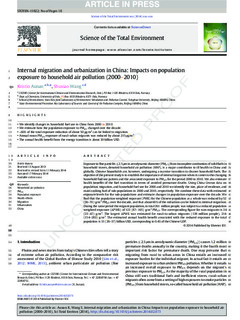| dc.contributor.author | Aunan, Kristin | |
| dc.contributor.author | Wang, Shuxiao | |
| dc.date.accessioned | 2018-01-15T16:00:31Z | |
| dc.date.available | 2018-01-15T16:00:31Z | |
| dc.date.created | 2014-02-17T18:02:46Z | |
| dc.date.issued | 2014 | |
| dc.identifier.citation | Science of the Total Environment. 2014, 481 (1), 186-195. | nb_NO |
| dc.identifier.issn | 0048-9697 | |
| dc.identifier.uri | http://hdl.handle.net/11250/2477649 | |
| dc.description | This is an accepted manuscript of an article published by Elsevier in Science of the Total Environment on 15 May 2014, available online: https://doi.org/10.1016/j.scitotenv.2014.02.073 | nb_NO |
| dc.description.abstract | Exposure to fine particles ≤2.5 μm in aerodynamic diameter (PM2.5) from incomplete combustion of solid fuels in household stoves, denoted household air pollution (HAP), is a major contributor to ill health in China and globally. Chinese households are, however, undergoing a massive transition to cleaner household fuels. The objective of the present study is to establish the importance of internal migration when it comes to the changing household fuel use pattern and the associated exposure to PM2.5 for the period 2000 to 2010. We also estimate health benefits of the fuel transition in terms of avoided premature deaths. Using China Census data on population, migration, and household fuel use for 2000 and 2010 we identify the size, place of residence, and main cooking fuel of sub-populations in 2000 and 2010, respectively. We combine these data with estimated exposure levels for the sub-populations and estimate changes in population exposure over the decade. We find that the population weighted exposure (PWE) for the Chinese population as a whole was reduced by 52(36–70) microgr/m3 PM2.5 over the decade, and that about 60% of the reduction can be linked to internal migration. During the same period the migrant population, in total 261 million people, was subject to a reduced population weighted exposure (PWE) of 123(87–165) g/m3 PM2.5. The corresponding figure for non-migrants is 34(23–47)microgr/m3. The largest PWE was estimated for rural-to-urban migrants (138 million people), 214 (154–283) microgr/m3. The estimated annual health benefit associated with the reduced exposure in the total population is 31 (26–37) billion USD, corresponding to 0.4% of the Chinese GDP | nb_NO |
| dc.language.iso | eng | nb_NO |
| dc.title | Internal migration and urbanization in China: Impacts on population exposure to household air pollution (2000-2010) | nb_NO |
| dc.type | Journal article | nb_NO |
| dc.type | Peer reviewed | nb_NO |
| dc.description.version | submittedVersion | nb_NO |
| dc.source.pagenumber | 186-195 | nb_NO |
| dc.source.volume | 481 | nb_NO |
| dc.source.journal | Science of the Total Environment | nb_NO |
| dc.source.issue | 1 | nb_NO |
| dc.identifier.doi | 10.1016/j.scitotenv.2014.02.073 | |
| dc.identifier.cristin | 1115888 | |
| dc.relation.project | Norges forskningsråd: 208277/F40 | nb_NO |
| dc.relation.project | Norges forskningsråd: 199491/S50 | nb_NO |
| cristin.unitcode | 7475,0,0,0 | |
| cristin.unitname | CICERO Senter for klimaforskning | |
| cristin.ispublished | true | |
| cristin.fulltext | preprint | |
| cristin.qualitycode | 2 | |
